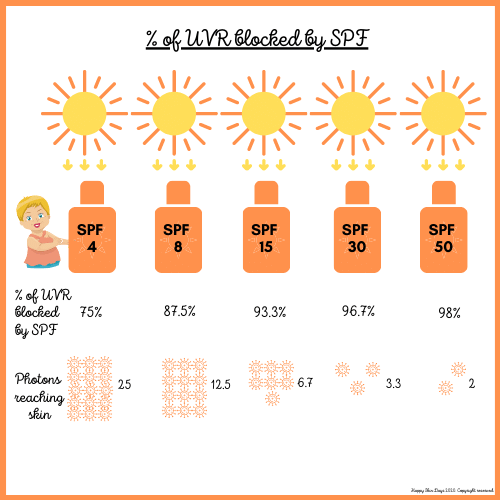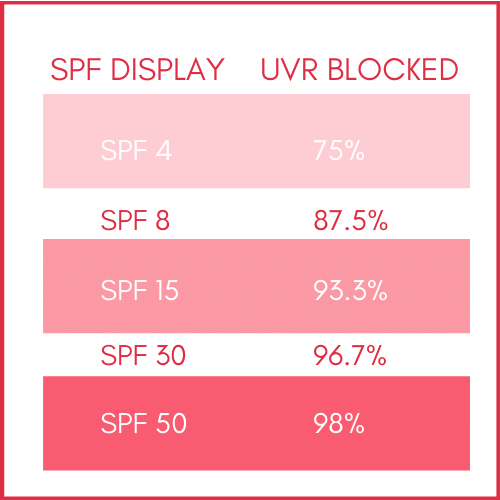Over the summer, there is a spike in interest in sunscreen and sometimes, its good to cover the basics – why do I only suggest SPF 30+ products.
What is UV radiation (UVR)?
UVR is a form of electromagnetic radiation made of tiny packets of energy (photons) which travel in a wave-like pattern, moving at the speed of light.
When photons reach the skin surface, they can be reflected, scattered or transmitted. Shorter wavelengths (UVB) undergo more scattering than longer wavelengths (UVA).
Photons tend to be absorbed by the skin and the wavelength of UV radiation determines the depth. UVB is absorbed by the epidermis only. UVA is absorbed by the epidermis and the dermis, where it does longer term structural damage.

UVA is a longer wavelength and is absorbed deeper into the skin, therefore even though it is of lower energy than UVB, it causes longer term structural damage to the skin.

What does sunscreen do?
The function of sunscreen filters is to reflect, absorb, scatter the photons that make-up UV radiation. But this is not a bullet-proof situation as no sunscreen will be able to 100% block UVR.
Sun Protection Factor (SPF) number, tells you how long it takes for your skin to burn (redness or erythema) with sunscreen compared to when no product is used at all.
Another way to look at SPF is how much UV radiation is blocked. Imagine UVR reaching your skin is not millions of photons, but just 100. This is how many photons, different SPFs protect against.

Source: Australian Radiation Protection and Nuclear Safety AgencyLet’s be honest…
The % UVR blocked is not massively different between SPFs 15, SPF 30 and SPF 50.
However, you have to think of it in relative terms: SPF 50 only permits 2/100 photons, while SPF 15 lets in 7/100 photons or nearly twice as much UVR. When UVR is made of millions of photons, this is a big deal for me.
Also, two other factors make the difference in SPF significant and both are behaviourial.
1) Applying less sunscreen than is recommended
we apply less sunscreen than the recommended amount of 2mg/cm2. On average, we apply 0.5 mg/cm2 – 1.2 mg/cm2 which is only a big deal because the SPF varies with thickness as follows:

Applying 50% of the recommended amount of SPF results in SPF 50 becoming SPF 17-SPF 37, which at its worst is a 65%+ reduction in SPF. SPF 30 becomes SPF 10-SPF 22.
This is why I never recommend low SPF products, because if your SPF 50 product can fall under SPF 20, what hope does SPF 15 product have?
2) Prolonged exposure to UVR and why I dislike SPF 100
Sunscreen gives individuals a false sense of security and this is worse at higher SPF products.
The International Cancer Agency has found that when people use high SPF sunscreen products, they intentionally expose themselves to larger doses of UVR.
I take that to mean that folks all of a sudden think they have some type UVR resistant skin. If they never normally step out during mid-day Chennai or New Delhi summer’s, they all of a sudden think that wearing SPF 100+ allows them to do so.
It doesn’t. Sunscreen just reduces the exposure to UVR – it doesn’t eliminate UVR risk. And as UVR damage is cumulative, intentional exposure to UVR only increases the risk of photoaging (wrinkles, hyper-pigmentation, loss of elasticity etc etc).
Finally, the Solar UV Index…
The Solar UV Index or UVI number measures the intensity of UVR at a given moment. The UVI number measures erythemal UVR and therefore, focuses on measuring UVB radiation.
Most countries, make publicly available a Solar UV Index, which is a single digit that’s used to give sun protection guidance.
This is the monthly UVI average for New Delhi and London for 2018.

If you live in New Delhi, 12 months of a year you have to wear sunscreen and in London its for 4 months of the year.
As most of my readers live in India, I suggest an SPF 30.
Closing
Just to put the fear of the Sunscreen God in you (again), you cannot afford not to use sunscreen and your skin (and wallet) will thank you in the years to come for using sunscreen every day of the year.
I suggest SPF 30 because you and I will consistently NEVER apply the correct amount of sunscreen 365 days a year. Also, I don’t want to encourage UVR risky behaviour, so I steer away from SPF 100.
That’s it from me. Drop me a line at email@happyskindays.com if you have any comments or questions.
